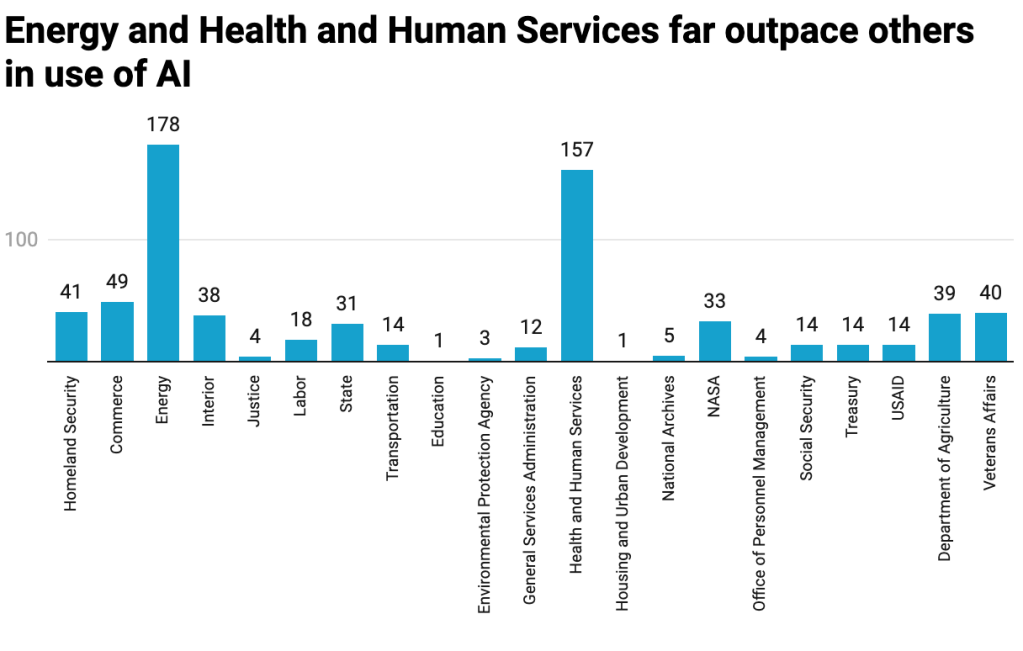U.S. government discloses more than 700 AI use cases as Biden administration promises regulation

The U.S. government has disclosed more than 700 artificial intelligence use cases among federal agencies, according to a new database uploaded to the AI.gov website.
This consolidated database, which is a compilation of individual postings from agencies, comes as the Biden administration promises to beef up regulation of AI, including through an upcoming executive order and new Office of Management and Budget guidance for the federal government.
The database provides the most comprehensive look at the government’s use of the budding technology to date. The inventories, which were required as part of a 2020 Trump administration executive order, have so far varied widely in terms of completion, formatting, timing and information reported, as tech policy researchers — particularly at Stanford — and FedScoop reporting have found.
The new database shows the government is using an extensive array of artificial intelligence tools, even as it gears up to further regulate and invest in the technology. The database also demonstrates that some agencies have done more to deploy and document their use of AI, particularly the Department of Energy and Health and Human Services, which have each disclosed more than 150 use cases.
“The whole point of collecting the use cases is to have them in one spot so that you could analyze them [and] learn about what other agencies are doing,” Lynne Parker, a former Biden and Trump administration AI official who worked on the original executive order, told FedScoop on Friday.
She added: “Having all the information in one spot for people to understand and look into and get a better grasp as to what the variety of use cases is, it’s just super important.”

Still, the number of disclosed cases was on the “low end” of the total count of use cases Parker expected. The wide range of AI use cases also raises concerns about to what extent OMB, in its updated guidance, will be able to effectively oversee the technology, she added. The AI Bill of Rights may not address many of the use cases disclosed by federal agencies, either, Parker said.
The consolidated data appears to be part of a revamp of AI.gov that’s underway. The main page of the site reads “NEW AI.GOV COMING SOON” as of the publication of this story, and includes a newly designed page dedicated to the government uses of AI.
The consolidated inventory differs from what some agencies have previously reported. The dataset appears to be missing more than 20 use cases disclosed by the Department of Energy, National Archives, Health and Human Services and the State Department, according to a similar consolidated dataset maintained by FedScoop. (The government’s database is only available for download on the AI.gov site, but FedScoop has made a digital version of the table available here.)
The consolidated database released on AI.gov also omits other details disclosed on some of the agency-specific use case inventories, such as information about whether these use cases deploy technology that’s created by contractors or built in-house. While some of the use cases disclose the status of these projects — for instance, some are in “development” while others are “pilot” — hundreds do not report any information about their development stage.
Similarly, the descriptions of AI techniques reported by agencies are inconsistent, ranging from “Artificial Intelligence Unknown” to “Natural Language Processing” to more detailed descriptions. Nearly 400 use cases don’t specify information about the AI techniques used.
OMB didn’t respond to FedScoop requests for comment about why the dataset was published now, its findings from the consolidated inventory and the discrepancies with agencies’ postings.
This new dataset is also not a complete inventory of all AI use cases within the federal government. Not all agencies were required to complete these inventories, and the agencies took different approaches to collecting use cases — despite CIO Council guidance outlining what the inventories should ultimately include.
“That’s the tough part about the fact that the definitions are a little bit squishy for this and the enforcement and accountability mechanisms are somewhat nonexistent here,” said Ben Winters, an attorney at the Electronic Privacy Information Center who has been following AI use cases. “Agency to agency, the person who’s designated has carte blanche of what to interpret as something they need to put in here.”
The Department of Transportation, for example, redacted many use cases in its inventory. The Department of Education included information about expenditures for its singular use case, which wasn’t part of the CIO Council’s guidance on what the inventories should disclose. The new consolidated dataset also continues to reference at least one use case that the State Department previously told FedScoop has been discontinued.
The state of inventories came up in a House Oversight subcommittee on cybersecurity, information technology and government innovation hearing held earlier this fall. Following that hearing, the subcommittee said the Biden administration was “delinquent” in following rules meant to guide federal agency use of AI and promised to press for action.
A major report from Stanford had previously highlighted patchwork compliance among federal agencies. Subsequent FedScoop reporting has also pointed to major challenges with federal agencies’ AI inventories.
Editor’s Note: This piece was updated soon after publication to quote Lynne Parker, who worked on the original executive order.






